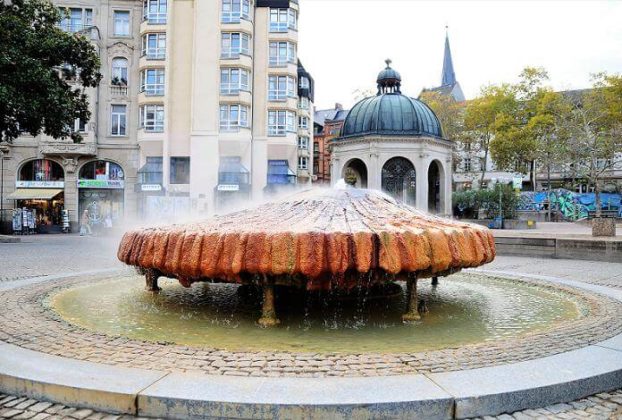I am unable to drink the water that has been offered. One sip is enough to tell me the brackish, acid taste of iron it carries is not for me. But my photographer is already reaching out to refill his glass, and so is our guide. Our guide bustles with health. She talks casually of skiing down the snow mountains that stand shadowing St Moritz; she walks with a stride that makes me wonder if she has spring on her feet. She often guides media and celebrities around, and a visit to the Forum Paracelsus is almost mandatory. Perhaps the water is the reason, I muse, for her glowing health.
The water we are holding is from a small fountain inside the rather imposing building that now houses the springs. The therapeutic values of these springs were first discovered and put to use around 1400 years BC. By the Middle Ages, word of the healing springs, reached beyond St Moritz, and Pope Leo X as well as the naturopath Paracelsus, after whom the bath is currently named, helped bolster its reputation further. Paracelsus combined chemical medicine and empirical, psychological healing to treat a number of maladies without resorting to surgery. The waters of St Moritz were perfect for putting his theory, of letting Nature heal, to effective use.
St Mauritius fountain
The taste of the water lingers as I wander through the large rooms and take in the St Mauritius Fountain, a large but decrepit fountain that dates back to the Bronze Age, embalmed behind a glass window. Touch screens and audio panels tell me of the curative properties of the waters, as well as share insights about the history. A large plaque reads out the composition of the water I have drunk. In brief, drinking it should help my stomach and intestines, make my blood redder, open blocked ducts and glands. It also prevents migraines, alleviates ear problems and clears mucus slime.
The waters have helped many chronic sufferers who come to stay at the town’s posh hotels to take therapeutic baths, and to drink the water. But I feel quite well, and I am glad I need not sip any more of it.
More healing waters in the Frankfurt Rhine region
Like St Moritz in Switzerland, other places in Europe are blessed with healing waters. None more blessed than Germany, perhaps. In fact, the Frankfurt Rhine-Main Region boasts of nine such towns with waters that cure a variety of illnesses. I visit two. The quaint and quiet town of Wiesbaden is one of them. Centuries ago, Wiesbaden was blessed with 26 hot springs, each of which was loaded with the fount of wellness. The legend goes that when the Romans first set up forts in Mainz, and crossed the Rhine on horses, they realised the horses loved to bathe in the warm floodplains of the river. Successful investigation into this phenomenon resulted in the discovery of the hidden hot springs, some hot enough to roast meat, others just warm enough to offer comfort on cold nights. Wies [ the fields ] and baden [bath] where the Romans enjoyed bathing 2000 years ago, was thus christened. Wiesbaden also contributed to fashion. The pink deposits were used by Roman women to add colour to their hair!
The 26 hot springs continued to garner attention, and soon Europe was paying homage to its healing powers. By 1370, 16 bath houses were counted. In 1800, the city boasted 23 bath houses. By 1900, Wiesbaden, a population of 86,100, would welcome 126,000 visitors every year. Among them were names like Johann Wolfgang von Goethe, Fyodor Dostoevsky, Richard Wagner, Johannes Brahms, and Henrik Pontoppidan.
Today, only 17 springs still flow. And at the start of the reconstructed old town that also hosts the hottest shopping centre with shops lining the streets and small eateries dotting the periphery, the old hot spring fountain stands, a perpetual fount of healing water. Famed for its ability to cure orthopaedic and rheumatic ailments, it welcomes any one who cannot afford the more expensive treatments in the clinics and hotel spas to collect the water and help alleviate their aches. For the rest, a variety of specialists and clinics offer treatment options using the spring waters, and spas like the Kaiser-Friedrich and the Aukammtal thermal baths offer visitors the chance to relax and recuperate.
Bad Homburg, a taste of luxury
On to the picturesque town of Bad Homburg, a 20-minute train ride from Frankfurt. Here‘s where the rich live, and the town breathes an air of luxury, right from the newly done windows at the railway station, to the flowering avenues and the glistening dome of the Russian church in the distance.
This is the town where the first casino was built. The first spa building followed, and the industry grew with the discovery of the Elisabethenbrunnen [Brunnen is German for “well”] in 1834. Two brothers built the casino, and were so successful in their enterprise that they later took over the Monte Carlo casino. When in 1860, the railway was born in its first avatar, connecting Bad Homburg to Frankfurt, the casino and the spas started drawing clients from all over, including rich Russians.
We seek a moment’s rest from the long hours of exploratory walking, and enter a beautiful church, restored to glory after it was ruined in the war. Inside between an old gracious statue of the Virgin Mary, and a modern sweeping version of Our Lady, the pews glisten emptily in the candle light. At the far end, two musicians are rehearsing. Brisk, happy music. It is heartwarming, especially in the evening cold. There are many therapies Bad Homburg has to offer, I think as we leave. Music too, among them.


